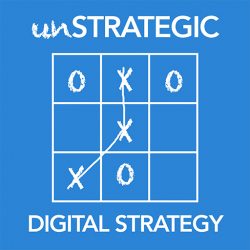Today is an auspicious occasion! It marks the first of my Strategy in Context series. As well as my first try at micro-blogging. I have a lot of information on topics like strategy, research, account management, user experience, and more. I’d like to get that information to the public as quick as possible while still posting good, quality content. Now, I’ll most likely expand on this series in an eventual strategy whitepaper.
I was recently at a tech conference asking people for strategy resources. One person firmly told me that “no one’s going to give me their strategy resources (or process for that matter) because that’s how agencies make the big bucks.” So, okay… that makes sense to me, but it doesn’t mean I can’t give away my strategy resources.
I’d like to address any nay-sayers about publishing digital strategy process, tactics, and/or resources. I come from the open source world where information is shared and the community benefits from that. This is my attempt to give back. I am more worried about people saturating the internet by building shitty things people don’t need, than I am about someone stealing my strategy process, theories, and thoughts. Plus, I want to spark discussion, so let’s begin.
Strategy in Context
I’m sure everyone is familiar with context-aware design, yeah? It’s when a device (like a smartphone) changes based on the environment in which it’s placed. Our smartphones can make recommendations based on location or auto-adjust the contrast on a bright day. Strategy in context is similar in the sense that we (as strategists) need to take into consideration our environments. And hopefully act accordingly.
Implementing a strategy process can be a daunting practice.
- A) it’s not a linear process
- B) it changes at every turn based on new information.
So, how do you conquer a client, project, or product when you aren’t sure how to proceed? You take a step back…and look at things from a holistic standpoint; from a bird’s eye view.
A Bird’s Eye View of Strategy
In order to understand strategy, there is one truth you have to realize: true strategy is continual, it’s not an end-game and never will be. The digital strategy that works for you today, might not be the one that works for you tomorrow, let alone a year from now. And this is why strategists are commodities, because it’s a job that never ends in the web and mobile space.
Holistically speaking, digital strategy is dependent on all its players. It is so entangled with other strategies that looking at it any other way would be a disservice to both you and your client.
The elements of strategy:
- The People: your client, their users, the competition, influencers, disruptors
- The Assets: things like their culture, their brand, their website, their digital assets are blanketed under this term
- The Operations: your client’s business model, their product or service
- The Frameworks: from your client’s organizational structure to the technical systems being leveraged.
- The Intelligence: the market, the trends, the innovation happening, the economic and political landscapes
- The Tactics: different from ‘operations’ – tactics are used to carry out strategies
- The Outcomes: the goals, the objectives, the accomplishments, the results
Contingent on each of these elements, strategy will have different meanings depending on its context. It’s too much to take in in a micro-blog post, so as the Strategy in Context series continues, I’ll drill into each one of these areas to give insight into breaking down your strategy process.
The Information Spectrum
At any given moment, there are hundreds of tiny shifts going on in the digital world. Developments that are slowly (or quickly) moving in from the fringes toward the mainstream. A fantastic trend report by Future Today Institute highlights innovation that is making it’s way toward being the established norm. Innovation is often talked about, but overlooked when it comes to strategy positioning.
In order to understand the information spectrum, you first have to understand all the new technologies, trends, and innovation taking place right now. But there are flaws in that thinking as one new technology supplants another. So, first thing you need to do — start building an information database. For all you strategists out there, you need some type of system where you can gather information and access it easily. I’ve built myself TheWebward.com – I call it my morning business review, but it’s really an information database.
You can try RSS aggregators like Digg Reader or create your own. But keeping up-to-date with the technology landscape is your first lesson in strategy. Did you know Baidu is leading the way in conversational interfaces? Or that Blockchain can help fight cyberattacks? Do you know what Blockchain is?
Lost in the Strategy Sky
As you begin your journey into strategy, you may feel lost at times. It happens to everyone and that’s okay. But if you’re lost and can’t find answers, look to other industries. One thing that’s helped me tremendously in developing my strategy process is turning to other sectors that have had strategists for decades. The military, politics, and the intelligence community all have resources on strategy out there that you can research. Then take their core principles and apply them to the digital space. Again, I’ll go into this more in upcoming posts, but I feel like this isn’t really a micro-blog post anymore!
Ok, more to come on Strategy in Context.

